Poison and Food Taboos
Our summer series, Perspectives from Anthropology of Food, continues with this post from Gastronomy student Madoka Sasa.
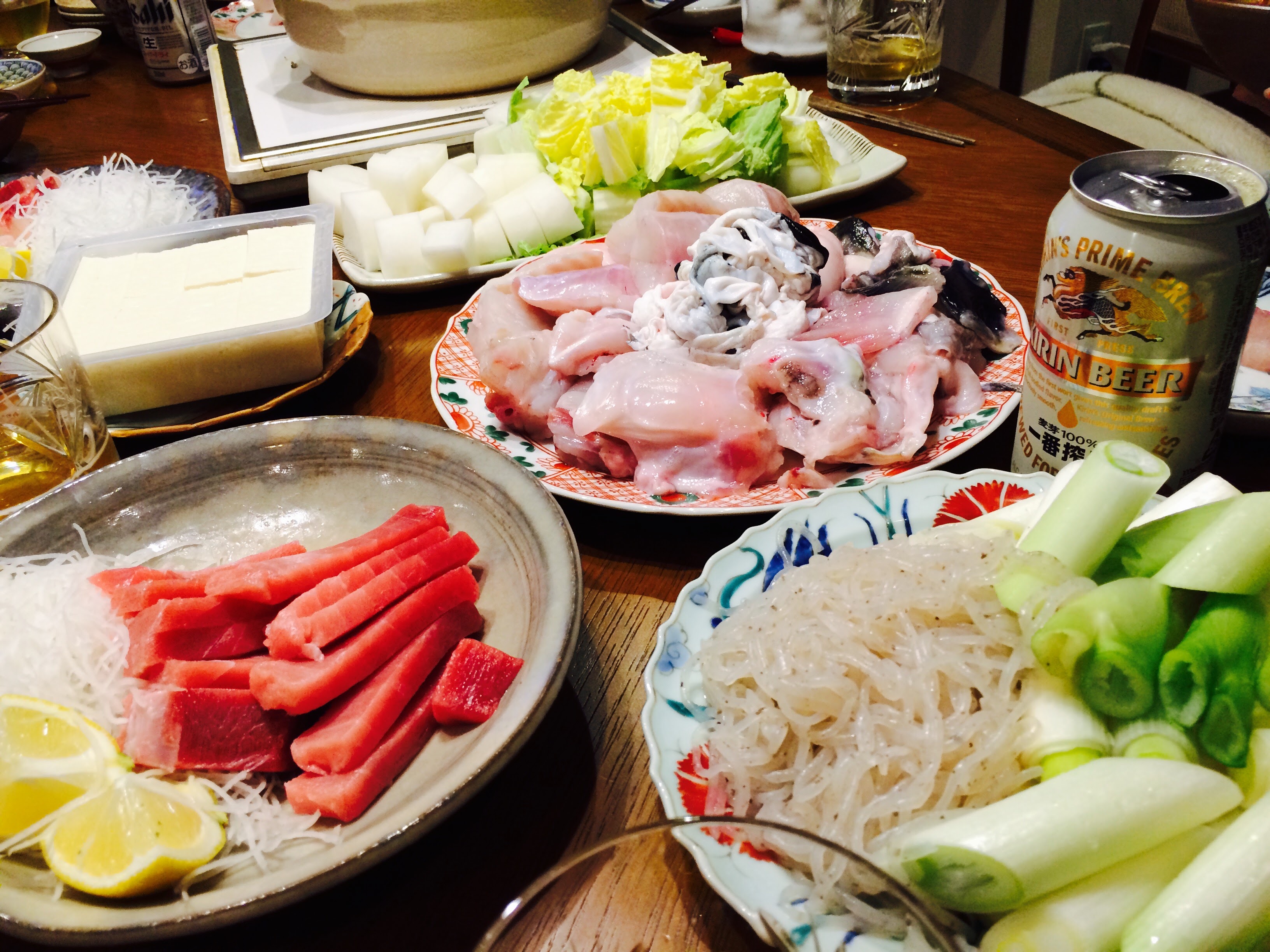
The center of the dish is skin of blowfish. (photo credit: Madoka Sasa)
In the article “Anthropology of Food,” R. Kenji Tierney and Emiko Ohnuki-Tierney (2012, 118) describe blowfish consumption in Japan:
Not all objectively “edible” items are regarded as food for a people, even in times of severe food shortages. For example, frogs are abhorred by the Ainu, while the French consider them a great delicacy. Some Japanese men relish blowfish, whose poison can kill instantly, not necessarily for its taste but in order to demonstrate masculinity.
I was impressed. This is the first time I had read that Japanese men eat blowfish to show their masculinity.
According to a brochure issued by the Japan Fisheries Resources Conservation Association (2002), Japanese people have been eating blowfish since the Jomon period (14000 B.C. - 4 B.C.). Nowadays, due to advances in processing technology, if you eat blowfish that is properly prepared, you will rarely get poisoned. However, blowfish poisoning has caused a lot of deaths throughout history, because there are different poisonous parts depending on types, and there are some types of blowfish that are difficult to distinguish from each other.
In researching food rules, preferences, taboos, and avoidance, many scholars have pointed out that accepting an invitation to a feast may not only be an act of solidarity but the invitation itself may also be a test of loyalty for the community (Bloch 1999; Carlson 1990; Nell 2015). Considering the question of why Japanese people continue to eat such dangerous fish, it seems reasonable to suggest that it is a show of masculinity rather than consumption for taste. As we know that there is a possibility of poisoning, this is a pretty serious test showing masculinity and loyalty. But this story leads me to ask another question. For whom did they eat blowfish? In other words, for whom did they take such a risk?
Indeed, it seems that the blowfish eating habit in Japan has sparked many such discussions over its long history. For example, in the brochure of the Japan Fisheries Resources Conservation Association (2002), it is said that Toyotomi Hideyoshi issued a ban on eating blowfish, as many samurai who gathered in Shimonoseki (a famous city for blowfish) were poisoned. In the Edo period (1573–1603), many feudal domains decided to ban eating blowfish. According to the Association for Japanese History and Travel (2014), it is said that when the head of a family died of blowfish poisoning, the family had its lineage abolished by the daimyō feudal lord, because “the head had lost his life due to his gluttonousness, though he was supposed to serve the daimyō at the risk of his life.”
On the other hand, Matsuo Bashō, a famous haiku poet in the Edo era, wrote a poem about blowfish (Japan Fisheries Resources Conservation Association 2002, 15):
Awanu koi Omoi kiru yoru Fukuto-jiru. (逢わぬ恋 思い切る夜 ふくと汁)
This is a poem about a broken heart. The speaker says, “I decided to give up because I cannot meet you. As I am so desperate, I will eat blowfish soup tonight.” It can be said that it is a poem that expresses a very disappointed feeling. But at the same time, it is somewhat humorous, implying that a broken heart is an excuse for eating blowfish soup, which is delicious but forbidden.
In addition to this, Bashō says, “You also have a relish of red snapper, but you go out of your way to eat blowfish. I will only just say that you are unwise” (Japan Fisheries Resources Conservation Association 2002, 15). It seems that we have no choice but to be amazed by the insatiable desire for eating blowfish among Japanese males, despite the serious danger of dying and becoming unable to fulfill our obligations.
From these descriptions, the following conclusion can be drawn. While there is a ruling class that prohibits people from eating blowfish to prevent them from dying, people in general cannot control their desire to eat. According to the Japan Fisheries Resources Conservation Association (2002), eating blowfish was pretty popular among ordinary people in the Edo era. In other word, regarding the question “for whom are they eating blowfish?” it seems that the answer is “for myself.”
To “eat to be happy” is too obvious. But I imagine that eating blowfish and showing masculinity is also a way to feel happiness, or even to pursue a better life. I can sympathize with the feeling that “I cannot resist eating my favorite food, even if it is not good for my health,” whether 400 years ago or today. In the same way, the act of showing masculinity by eating puffer fish is an act that I can understand as reasonable if I know when, who, and under what circumstances it occurred. And this resonates with one of the themes of anthropology, understanding other cultural perspectives. For example, the people of Malagasy, observed by Maurice Bloch (1999), ingest an “antidote” when they have to eat with people from different villages or distant relatives. This helps eliminate discomfort and stress caused by unintentional shortening of the distance with a person who is not close. Although their culture is quite different from mine, the situations where people feel stressed are similar. In other words, even though the act of other cultures seems to be unusual, I think the feeling underlying the act is often understandable for us: making good relationships with others, satisfying self-respect, or relieving stress. So it is very interesting for me to find the similarity of mind beyond time and culture, and to see each culture’s interpretation of the world that is used to make life more comfortable.
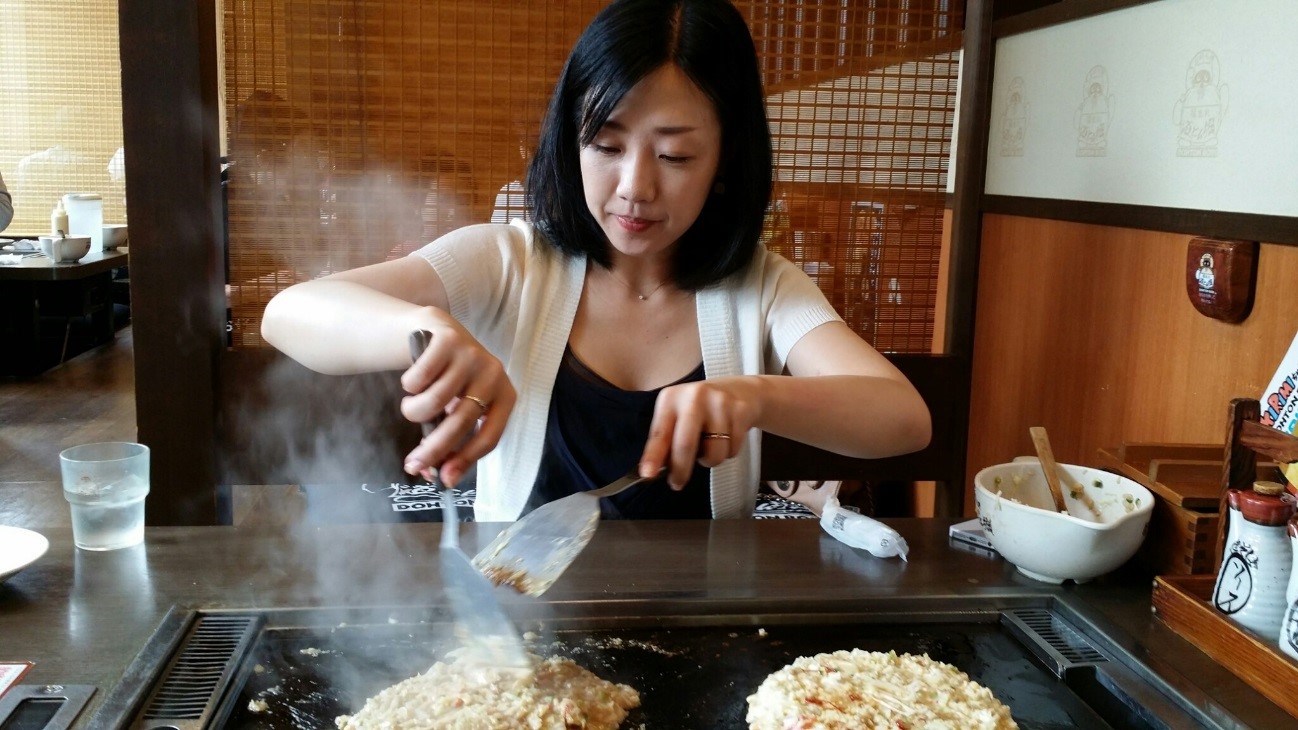
It is well known that various cultures around the world have “food” that is “good to eat” which is unacceptable for people in other cultures, for example, clay, dogs, insects, dolphins and so on. However, the reason for eating them could be something which many people can feel sympathy toward. It makes me more interested in thinking about food rules, preferences, taboos, and avoidance.
Bibliography
Association for Japanese History and Travel. 2014. “Shimonoseki ni Fuku wo Maneita Fugu.” Accessed June 29, 2017. http://japan-history-travel.com/?p=3950.
Bloch, Maurice. 1999. “Commensality and Poisoning.” Social Research 66 (1):133–49.
Carlson, Robert G. 1990. “Banana Beer, Reciprocity, and Ancestor Propitiation Among the Haya of Bukoba, Tanzania.” Ethnology 29(4): 297–311.
Krögel, Alison. 2009. “Dangerous Repasts: Food and the Supernatural in the Quechua Oral Tradition.” Food and Foodways 17 (2):104–32.
Nell, Cornelia A. 2015. “Commensality and Sharing in an Andean Community in Bolivia.” In Commensality: From Everyday Food to Feast, edited by Susanne Kerner, Cynthia Chou, and Morten Warmind, 165–76. New York: Bloomsbury.
Nihon Suisan Shigen Hogo Kyokai. 2002. Waga Kuni no Suisangyo Shirizu: Fugu. Accessed June 29, 2017. http://www.fish-jfrca.jp/02/pdf/pamphlet/074.pdf.
Tierney, R. Kenji, and Emiko Ohnuki-Tierney. 2012. “Anthropology of Food.” In Oxford Handbook of Food History, edited by Jeffrey M. Pilcher, 117–34. New York: Oxford University Press.
Food Mapping: Growing Community at Brookline Grown
Gastronomy student Madison Trapkin shares her food mapping work from Anthropology of Food.
In the metropolitan sprawl that is the Greater Boston area, consumers have a wide variety of grocery stores to choose from. There are major chains like Stop & Shop and Trader Joe’s, or somewhere like Whole Foods if you have a bit more disposable income. For those who live in the vicinity of the Brookline neighborhood, there is also the option of shopping at Brookline Grown, a relatively small grocery store that is bringing fresh, local foods to their clientele. Brookline Grown is one example of the purveyors of local foods and food related products that have been cropping up across the United States that encourage customers (quite literally) to bring the farm to their tables.
In this mapping exercise, I consider Brookline Grown as an example of the larger food movement towards local and sustainable agriculture. I discuss the layout of the store and focus on four specific products, as well as what each indicates about foodways, identity, relationship, and current food trends. There are certain aspects of locally sourced foods and food products that cannot be attained from processed, generic, and otherwise large-scale farmed foods. I also examine the various ways in which buying local can strengthen community bonds and encourage positive relationships with growers and producers of local foods.

In order to create this map of Brookline Grown I visited their store. They are located near Coolidge Corner on Pleasant Street. The unassuming exterior of Brookline Grown gives way to the plethora of locally sourced delicacies within its walls. The various products that fill their shelves and baskets are all sourced within a 7-mile radius, which impressed me given their proximity to the city’s elements. Rather than provide an exact to-scale representation of the shop’s interior, I decided to focus on the sourcing of four specific products. I selected items from different food groups in order to provide diverse coverage of the store’s offerings: sweet potatoes, milk, greens, and sriracha (a type of hot sauce). I chose to illustrate one wall from the store and from that honed in on the products I had chosen, including a small map of Massachusetts with every chosen item. Each map of Massachusetts includes a red dot that indicates where the selected item was grown or produced. My goal was to indicate the proximity of production to Boston. Brookline Grown is a proponent of the farm to table movement, which has secured an important spot in this nation’s food history as a direct response to the explosion of commoditized processed foods that began in the 70s. Therefore, it was important for me to emphasize the locality of each item.
The Anthropology of Food: Something Strange, Something Familial
Dr. Ellen Rovner will teach MET ML 641, The Anthropology of Food, during the fall 2017 semester and has prepared this Course Spotlight.

By Pietro Lorenzetti - The Yorck Project: 10.000 Meisterwerke der Malerei. DVD-ROM, 2002. ISBN 3936122202. Distributed by DIRECTMEDIA Publishing GmbH., Public Domain, https://commons.wikimedia.org/w/index.php?curid=154045
Anthropologists like to say that the study of anthropology makes the strange familiar and the familiar strange. Whether the “strange” is a Japanese Sumo wrestler’s eating habits, a medieval German nun’s fasts, or the person next door’s “exotic” cooking, anthropologists believe and practice that only through knowing the “other,” do we know ourselves. What does this mean for those of us who will be together for The Anthropology of Food this fall semester? First and foremost, we will be looking at the study of food cross-culturally as central to the understanding of humankind and society. The famous anthropologist Claude Levi-Strauss said that food is not just good to eat; food is also good to think with. In other words, what do people’s everyday food practices, rituals, traditions, beliefs, and preferences cross-culturally and at home say to us about whom we are and the worlds we inhabit?
Using our food-focused lens to examine critical social issues related to class, race, human migrations, globalization, ethnicity, alternative food systems, and gender, this semester students will immerse themselves in anthropology’s signature methodology, participant observation, and conduct ethnographic research. Choosing a food-related topic that personally resonates for the student, each member of the class will participate in a semester long qualitative study in the Boston area to familiarize themselves with field methods and to hone critical thinking. In past semesters, students’ projects have covered a fascinating range of topics such as how global food systems contribute to re-creating “home” for non-American residents, class meanings of “farm to table” in restaurants, and eating at the movies.
Anthropology of Food is structured as a seminar; students are encouraged to lead as well as participate in discussions. Along the way, our learning is enhanced with live on-line sessions, movies, guest speakers, field trips to local food sites related to our readings, and most importantly, with snack breaks that highlight our own food rituals, traditions, and preferences. Familiarizing the strange and making the strange the familiar, Anthropology of Food presents food as both good to eat and good to think with! Please join us!
MET ML 641 C1, Anthropology of Food will meet on Wednesday evenings from 6 to 8:45 PM, beginning on September 6. Registration information can be found here.
Oyster on the Rise
 Gastronomy student Allison Keir shares her thoughts on the "oyster revival" in the next of our summer blog series, Perspective from Anthropology of Food.
Gastronomy student Allison Keir shares her thoughts on the "oyster revival" in the next of our summer blog series, Perspective from Anthropology of Food.
Over the last ten years, oysters have been making a come back into the mainstream food scene. Oyster bars and buck-a-shuck happy hours are popping up all around the metropolitan areas. Why, might you ask, is this re-emergence happening? About a hundred years ago there was an abundance of oyster beds along our coastlines that were slowly depleted from pollution, overfishing, and destruction. Many people don’t know that New York Harbor was once known to be the mecca for harvesting oysters until consumers started getting sick from eating the raw shellfish. Thus, oysters as a sellable food product were shut down and slowly drifted from the food scene. Author Mark Kurlansky recounts the history of oysters once dominating the food scene of New York Harbor in The Big Oyster: History on the Half Shell. "Before the 20th century, when people thought of New York, they thought of oysters," Kurlansky writes (2006:95).
At the time, what policy makers and the locals didn’t understand was that it wasn’t the oysters that were bad for consumers; it was the sewage that was being dumped right into the same water from which the oysters were harvested. Later on, the Clean Water Act was created, and oysters and other shellfish were no longer permitted for harvest in water that wasn’t within “Class A” water quality. Not only did this protect our seafood, it helped to clean our waterways. Since then, oysters have been slowly making their way back into the food scene.
Oysters are in a revival and are thriving in a new socialite food scene filled with consumers who are becoming more aware of the environmental benefits of oysters. It only takes one of these bouldering bivalves to filter up to 50 gallons of water per day. Oysters are also one of the most sustainable forms of protein out there; in comparison to beef, their digestive systems reduce and live off waste and other toxins in our waterways, turning the waste into food for themselves and cleaner water for us! They are naturally reducing the nitrogen levels in our waterways that have been a major component in ocean acidification and the depletion of our marine life.
 Considering the cost of each oyster at any given raw bar, you could favor oysters as the elite class of mollusks. The pure deliciousness of eating fresh raw oysters while sipping on some wine or micro brew beer has gotten many consumers in the mainstream food scene hooked. Ironically you don’t even need a hook to catch an oyster! Still, oysters are an acquired taste and many people see them as blubbery textured creatures with a marshy flavor, while others think of them as a delicate salty and sweet jewel of the ocean that is comparable to kissing the sea.
Considering the cost of each oyster at any given raw bar, you could favor oysters as the elite class of mollusks. The pure deliciousness of eating fresh raw oysters while sipping on some wine or micro brew beer has gotten many consumers in the mainstream food scene hooked. Ironically you don’t even need a hook to catch an oyster! Still, oysters are an acquired taste and many people see them as blubbery textured creatures with a marshy flavor, while others think of them as a delicate salty and sweet jewel of the ocean that is comparable to kissing the sea.
So what is driving the surge in popularity for this tasty bivalve? While some consumers may be aware of the ecological benefits of protecting our oyster beds, it is possible that the taste for oysters is not just an ecological, but also a social phenomenon. Oysters have emerged back into the mainstream food scene and are being wined and dined with all walks of life. You don’t have to go down to the docks to see oysters being served on the half shell. You can just go to your local watering hole down the street or make a reservation at a nearby seafood restaurant so you can sit at the raw bar and enjoy the experience of watching the oysters get shucked!
Instant Pot as Community
We continue with our summer blog series “Perspectives from Anthropology of Food” with this post from Laura Kitchings. This series presents work written by the students in the summer Anthropology of Food class (ML 641) in which they reflect on current issues, discuss assignments they have worked on, or address topics of particular interest to them.
My participation in the Anthropology of Food course led me to reflect on my participation in the moderated Facebook group, Instant Pot Community. As of June 25th, 2017, the group had 520,441 members.

For those who don’t know, the Instant Pot (produced by the Instant Pot company) is an electronic multi-cooker that acts as a slow cooker, electric pressure cooker, rice cooker, steamer, yogurt maker, and sauté pan, depending on the chosen setting. It features multiple safety features to calm the fears of those who have memories of explosions caused by earlier generations of pressure cookers. Several models of the Instant Pot are available at kitchen and online retailers at various price points, and many are purchased through third party sellers. Breville, All-Clad, and other companies now produce similar products, but what sets the Instant Pot apart is the company’s focus on the creation and moderation of its Facebook community.
On an average day, posts cover a variety of topics related to cooking in the appliance. Sample posts include: a military wife describing the appliance to her deployed husband, a mother asking for advice on preparing meals for a child recently diagnosed with celiac disease, and a question about how to best cook frozen chicken wings in the appliance. Almost all posts receive a reply from another group member within minutes. Throughout the threads, jokes about being a Pot Head abound, specialized terms such as NR (natural release) and PiP cooking (cooking in another container within the appliance) are used, photographs of customized decals placed on the outside of the appliance are shared, and links to amateur YouTube videos of food preparation using the Instant Pot are shared. Four employees of the company moderate the group and regularly close comment threads for inappropriate content.
In the class we discussed the practice of “doing-cooking” from Luce Giard’s chapter on “Gesture Sequences” in the larger work, The Practice of Everyday Life by Certeau, Giard, and Mayol (1998). In this chapter, Giard discusses how daily cooking involves both the mind and body. She discusses how the mind works to organize, make decisions, improvise, and a host of other activities, while the body mixes, stirs, and performs the actions needed for cooking. For me, this article contextualizes the number of posts from people trying to multi-task while cooking. As shown by Giard, the mind and body are already fully occupied during the process of planning a meal and cooking. People post about being interrupted while cooking to breastfeed their children, about dogs who need to be taken outside, children working on homework, and numerous other daily realities. Members of the Facebook community post about how the Instant Pot allows them to take fewer physical actions during the creation of a meal, and also how the Keep Warm function of the Instant Pot means that even if the dish is finished, it does not need to be eaten immediately. People also post about how the food cooking in the Instant Pot does not need to be monitored (or, as referred to in posts, “Baby-Sat”) while cooking. So the cooks can physically and/or mentally attend to other tasks while the food cooks without a risk of burning or kitchen fire. Other posts share recipes related to a variety of diets, or express budgetary concerns. This assists with the mental decisions needed to create a meal within the dietary needs and budget of the particular household.
In a 2011 article in American Ethnologist, Gagné discusses how urban farmer’s markets serve as a “Third Place.” A “Third Place” typically develops as an accessible space outside of work and home where the regulars have no obligation to spend time. According to Gagné, urban farmer’s markets provide an accommodating location where conversation between regulars is prioritized. Starbucks has also been studied as an example of “Third Place” in an article by En-Yin Lin. In this article, Starbucks provides a comfortable, consistent physical environment for the consumer to construct their personal and social identities, while publically consuming a product that fits their developing idealized view of themselves (Lin 2012).
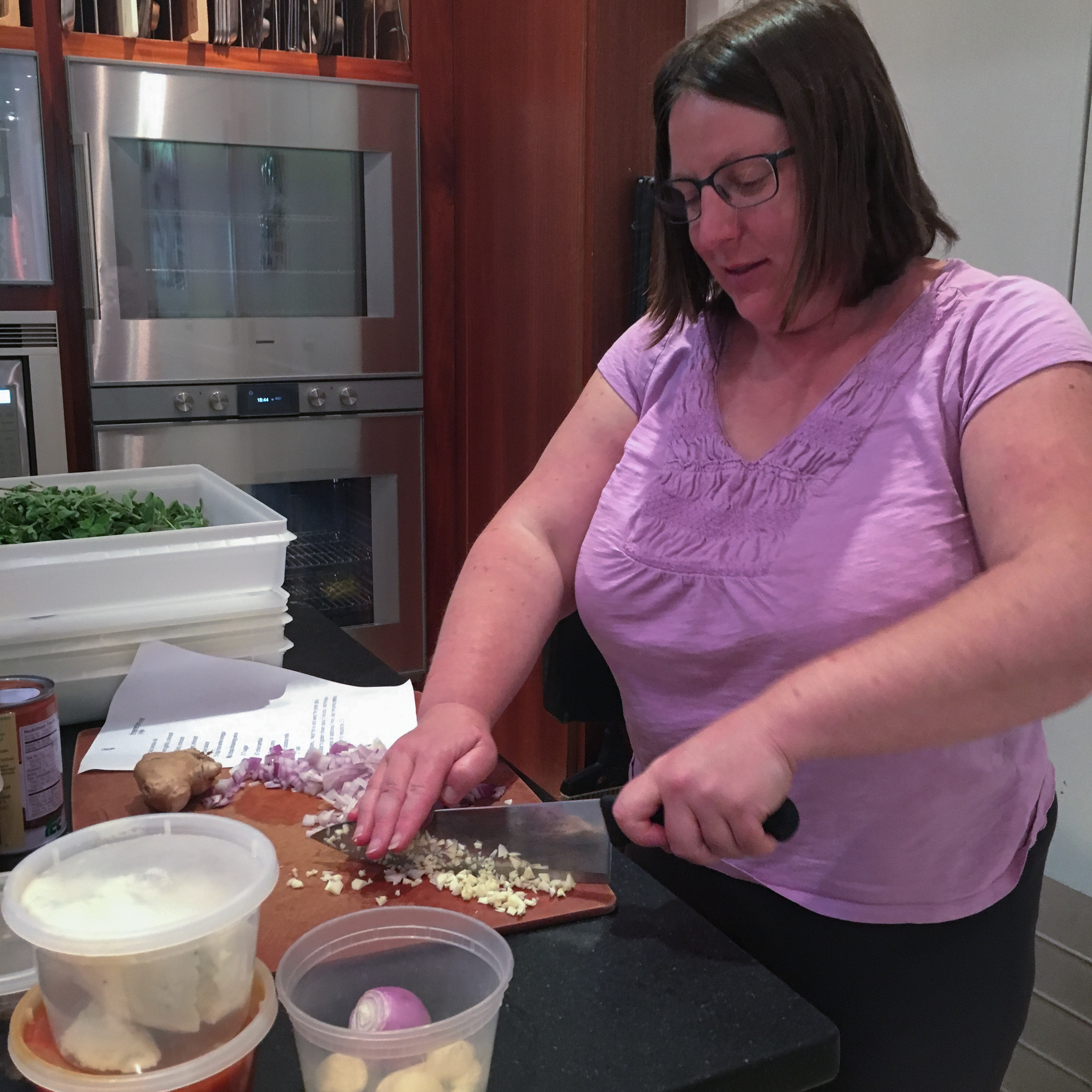
The Facebook group for the Instant Pot acts as an online “Third Place,” one that celebrates the constant ritual of doing cooking. While there is no obligation for participation in the community, the online space allows the participants to showcase and develop their identities. The only requirements of participation are that posts tangentially relate to the Instant Pot and follow the rules set by the moderators. The underlying conversation in the majority of the posts is the challenge of creating meals that meet the nutritional needs of the participant’s households within a budget. Participants also share their frustration that their meal creations are not appreciated by the household, and often find this appreciation in the Facebook group. Like the Farmer’s Markets, the Facebook group often provides its members with a bit of culinary tourism, as individuals may follow threads related to foods that are unfamiliar and are introduced to additional online cooking resources by other members. The Facebook community is similar to the Starbucks experience as the Instant Pot company provides a comfortable, consistent, online environment. In this environment, the participants showcase their developing identities while publically stating their appreciation for an appliance that makes meal preparation easier.
In short, the Instant Pot Facebook Group is an excellent example of “Third Place.” Beneath the day-to-day exchange of information of cooking with this appliance, there is another discourse—one in which users can share their frustration around the day-to-day mental and physical realities of cooking, share advice around meal planning, and publically develop their own individual identities as meal creators.
Refusing Food to Create an Identity
Our summer blog series “Perspectives from Anthropology of Food” presents work written by the students in the summer Anthropology of Food class (ML 641) in which they reflect on current issues, discuss assignments they have worked on, or address topics of particular interest to them. Today’s post is from Emma Herman, a student in the Nutrition Program at Boston University's Sargent College

As a dietetic student I am excited for the opportunity to work with people in modifying their diets for optimal health. After taking Anthropology of Food, I promise to always consider their cultural and familial food consumption habits first. American diet culture has a nasty habit of judging other people’s food choices and idealizing certain food habits over others. Why can’t so and so stop eating the macaroni and eat some kale? The industry has the habit of telling people to stop eating whole food groups without considering what these food items might mean culturally and to focus instead on grams of macronutrients or levels of vitamins.
What a person chooses to eat tells their story. It may imply religious beliefs, personal values, or cultural and ethnic heritage. Telling someone to avoid rice may actually create more issues than it solves. Did this person grow up in a household that considers a meal incomplete without rice? Was their recipe for rice passed down for generations? Does eating a separate meal from their family create a feeling of exclusion? If a person of their own volition chooses to follow a new diet trend, this too is a way of expressing personality and cultural group inclusion. As food trends like the Whole 30 and vegan diets pop up all over my social media page, I realize that this too is a way of telling the world “I belong to this group.” Pledging allegiance to vegan eating or avoiding non-sustainable seafood says who you would like to be, this is a change you are making purposefully, while food avoidances you grew up with, like kosher or halal eating may honor your cultural heritage.

In Eating Animals, Jonathan Safran Foer tells the story of his grandmother who starved during World War II. Towards the end of the war, a Russian Farmer offered her a piece of pork, which she refused. When her grandson questions this choice—“But not even to save your life?”—she answers, “If nothing matters, there’s nothing to save.” When you have nothing else left, you can still choose what you will and will not eat. Her identity as a Jew was strongly tied to her kosher diet; giving that up would have made her feel like her identity had been stripped completely, and she would have nothing left to save (Foer 2009).
Eating is a necessity, and those of us who are lucky get to choose what we eat several times a day. Our food choices reflect who we are, and when stripped of all other identifying features like home and family, you still must eat to survive. Rejecting food while starving might seem strange, but it can be a way of preserving identity when you have nothing else to save.
Works Cited:
Foer, Jonathan Safran. 2009. Eating Animals. Boston: Little, Brown and Company.
An Interview with an American in Benin
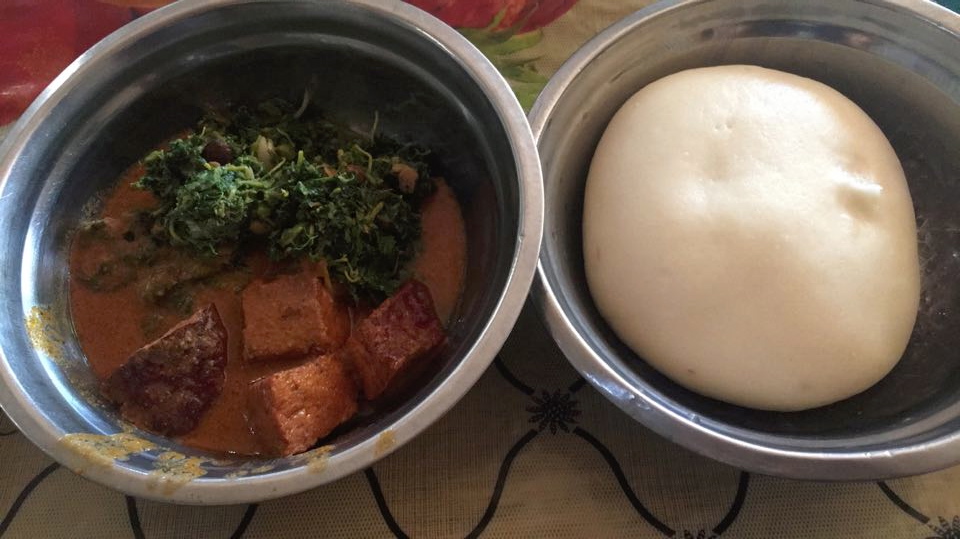
The next entry in our summer blog series “Perspectives from Anthropology of Food” is by Gastronomy student Sydney Manning. This series presents work written by the students in the summer Anthropology of Food class (ML 641) in which they reflect on current issues, discuss assignments they have worked on, or address topics of particular interest to them.
Benin is a small francophone country in West Africa that shares borders with fellow French-speaking Togo, and Nigeria. The population of Benin is close to 11 million, with eight ethnic groups represented, and the two major religions observed in the country are Islam and Roman Catholicism. In writing this blog for my Anthropology of Food class, I knew very little about Benin culture, so I contacted a childhood friend for more information. Andrea*, who graduated with a master’s degree in business with additional studies in anthropology, was born and raised in the midwestern United States, and is now a community economic development specialist in the Peace Corps stationed in Benin. She was initially assigned to service in Mali but due to an uptick in terrorism, she was offered a position in Benin, where she has been living and working since January 2016. Because Andrea is American and comes from an anthropological background, I was curious to learn about her observations as a contributing member of Benin society as they relate to food.
Going into this interview, I first wanted to know Andrea’s food expectations about Benin. What was she expecting? Was she worried there would be no comforts of home? “I didn't

come expecting to eat American food, whatever ‘American food’ is,” she said. “I was expecting [the food] to be like Mali, but [Benin] is a little better off, so you see more variety.” Since her arrival, Andrea has had the opportunity to try many different traditional Benin dishes such as Piron, made from garri which is dried, shredded cassava, usually eaten with grilled pork, onion, and a hot pepper sauce, and Pate Blanche, a staple in the Benin diet which is made from corn flour, usually served with some type of sauce and sometimes meat. And while she was not expecting to find western comfort foods, she was pleased to learn that she wouldn’t have to travel far if ever she had a craving for American-style burgers, lasagna, or hotdogs, all of which are available. “That was a nice surprise,” she said.
I was curious to know what a typical Benin breakfast for Andrea is like. Her answer? It depends. Sometimes she will opt for an egg on a baguette (“There is a large French influence here, so you see a lot of baguettes and pastries around.”). Alternatively, she will have Atassi, a rice and bean dish that is usually eaten with either cheese or sodja (soy cheese).
As in many African countries, open-air markets are not only vital for commerce in Benin, but for social interaction as well. When Andrea is at her work site, she visits the markets twice a week, and has seen firsthand how serious these markets can be. “I live in Parakou, the second largest city in Benin; it has over 250,000 residents so there is no way for me to even start to describe how busy and hectic it is,” she said. “There are over 100 venders at the market selling a variety of items ranging from fresh produce, cheese, and meats, to scarves and fabric. On Saturday, the big market day, people come from as far as Nigeria to sell.” Also interesting to note is how gender is represented at the market: “Food venders are for the most part women, unless they’re selling street meat, which is cooked meat sold usually with a pepper seasoning. I’ve never seen a woman selling [street meat],” Andrea said.
When it comes to the preparation of food, women primarily take care of all of the cooking. While some men do know how to prepare dishes, Andrea said, for the most part, it is the job of the woman to nourish her household. There is a difference made between men, women, and children when it comes to commensality as well. Men eat from a large communal bowl or plate, while the women and children are given separate plates. There is also a specific order in which each member of the household receives their food. “For the most part,” Andrea said, “the oldest and head of the household is served and eats first, and the father or male of the household usually eats separate from the rest of the household. After that, the order depends on the household. Many people serve the children last after all of the adults have eaten. The domestic worker, or whoever is serving the food, would eat after the children.”
Although Benin is not a predominately Muslim country, one aspect of eating that is widely practiced is that of using the right hand to gather food, while never using the left hand, which in the days of Mohammad was considered unclean. Andrea also noted the emphasis on hospitality, which is deemed a duty to uphold in the Islamic faith. In Benin, if you are eating and a person passes you, you are obligated to invite that person to share your meal.
Andrea’s time in Benin will be ending in a few months. As a person who has known her for most of her life, I can tell how impactful working in Benin has been for Andrea. She has travelled and experienced so much of what Africa has to offer. When asked what she would miss the most about her time in Benin specifically, it was without a doubt the food. “I will miss everything about the food,” she said. “I have literally made friends in this country because of food. It’s such a big part of the culture, and it brings people together. I’ve fallen in love with the food here, [and] I’ve gained like, 20 pounds, so you know it’s a serious problem!”
Andrea’s descriptions of her observations and experiences in Benin highlighted several key themes that have been discussed in class. The first theme is the importance of familial hierarchy as it relates to food, as well as food rules observed in the home. Her descriptions also highlighted the importance of hospitality, a cultural phenomenon that is practiced in the west as well as the east. After speaking with Andrea, my interest in visiting Benin and experiencing both the cuisine as well as a different dialect of French, has been piqued. Perhaps for now I will have to settle for trusted recipes found in a Benin-focused cookbook or two.
*name has been changed
Rethinking Food Language
Gastronomy student Sarah Wu shares her thoughts on rethinking food language in the next of our summer blog series, Perspective from Anthropology of Food.
My first months in the Gastronomy program at Boston University have been nothing short of eye-opening. I’ve been challenged to rethink what I know about food, the industry, and the people behind it. In particular, one subject has been discussed in multiple classes, including Anthropology of Food—the language of food. I’m not talking about the usage of terms such as antipasto or the difference between a macaroon and a macaron (though it is one of my pet peeves when people can’t tell the difference)—I’m talking about re-evaluating the way we use words such as “authentic,” “original,” and “traditional.” A lot of things we say about food are strictly opinion—something is too sweet, salty, sour, bitter, rare, or overcooked. However, the respective meanings of the three aforementioned words are even more difficult to pin down. If something is sweet, we can agree that there are degrees of sweetness (too sweet, not sweet enough, etc.), but with words like authentic, can something be semi-authentic? I think not.
"Original," "traditional" and "authentic" recipe images from http://recipecurio.com/
Merriam-Webster offers three definitions for the word “authentic,” two of which are most relevant to my discussion: “conforming to an original so as to reproduce essential features” and “made or done the same way as an original.” However, it almost feels as if Merriam-Webster is defining the word by using the word—although not exactly the same word, “original” also has a blurred definition. “Original” recipe means virtually nothing to me.
Truthfully, authenticity is not something that can be gradable. The definition differs from person to person. For some, if it doesn't taste like “home,” it's not authentic. If you visit a restaurant that has similar flavors to home, you may consider it authentic in your book. It depends on the time, place, ingredients, and preparation methods of the food, among other factors. Something can be authentic to a specific time or place, but after that moment, the definition has changed once again.
In terms of specific foods, usage or lack of certain ingredients is simply a difference in regional cuisine. We try to squeeze food into a box, when in reality food expands much beyond that. Food in one town could have completely different flavors than the next town over. We are quick to judge that a not-as-widely-known cuisine is automatically inauthentic. Through immigration and movement of peoples, exact ingredients are often difficult to find, and we find ourselves trying to create a dish as close to the supposed original as possible. If something were made EXACTLY the same way using the EXACT same ingredients, it would be just that—the same.

Perhaps the avoidance of words such as authenticity can help clarify our writing in cookbooks or in recipes. Preparing what your mom made may be authentic to you, but a complete imposter to another. Describing the experience and feelings you want another to feel while creating and enjoying the dish gives a lot more meaning to food than words like authentic. The history behind the dish and the people who created it paints a much better picture than a single word, perhaps one time when being brief is not the best approach. Putting a familiar lens on a potentially foreign recipe helps us appreciate others’ tried and true methods of food.
Works Cited
Merriam-Webster Dictionary. 2017. “Authentic.” Accessed June 24, 2017.
The Power of Food Memories in Identity Formation
We continue with our summer blog series “Perspectives from Anthropology of Food” with this post from Gastronomy student Valencia Baker. This series presents work written by the students in the summer Anthropology of Food class (ML 641) in which they reflect on current issues, discuss assignments they have worked on, or address topics of particular interest to them.
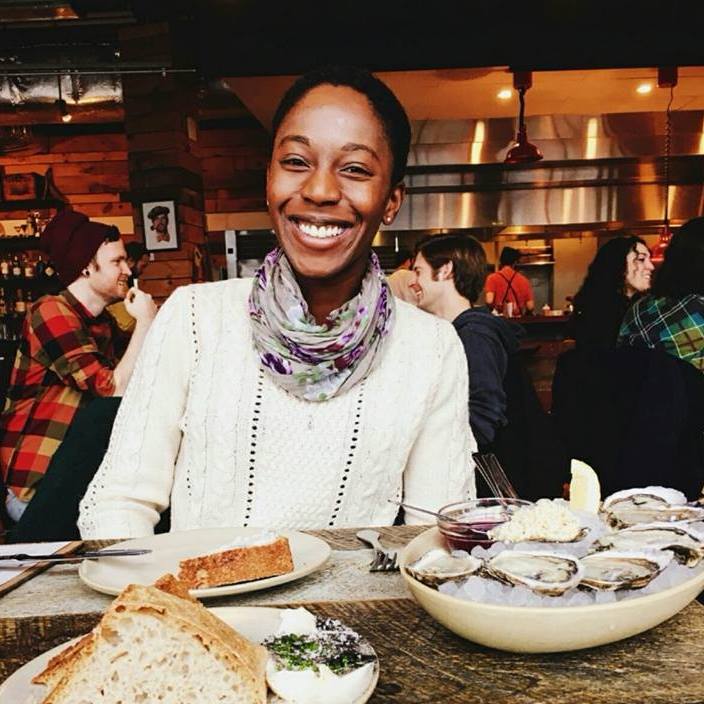 For several months now, I’ve been intrigued by the interconnections of memory, food, and identity. Identity making is a key point of interest for the socio-cultural anthropologist; those who use food as their primary mode of scholarship research would be amiss to overlook the power and significance that memories have on the construction of identity. Specifically, sense memories are an integral part of each and every one of our autobiographical recollections. It is a titanic understatement to say that we, as social researchers, leaders, and cultural curators, have so far undervalued the significance of the “lower tactile” senses and their value to our food experiences.
For several months now, I’ve been intrigued by the interconnections of memory, food, and identity. Identity making is a key point of interest for the socio-cultural anthropologist; those who use food as their primary mode of scholarship research would be amiss to overlook the power and significance that memories have on the construction of identity. Specifically, sense memories are an integral part of each and every one of our autobiographical recollections. It is a titanic understatement to say that we, as social researchers, leaders, and cultural curators, have so far undervalued the significance of the “lower tactile” senses and their value to our food experiences.
Aspects of our personal narratives are most intensely and emotionally recalled, and potentially re-learned, through memories associated with moments of taste, smell, sound, and touch. Our brain’s emotion centers are nearest to the brain’s taste and smell processing centers, so it is undeniable that our understandings of self are interrelated to these senses and that food experiences have great association with them. In Remembrance of Things Past, Marcel Proust (1981) reflects that remembering is not just reserved for thinking about past visual moments, but rather that remembering can be reliving and relearning events, places, and people of the past. Involuntary memories come up when we smell a scent, or like Proust, taste a particular flavor from our past. These involuntary memories help us to vividly recall not just the taste or smell, but also social associations, personal events, people, and relationships tied to the smell or taste. Our sense memories offer moments to reconsider our pasts, and so — as past is tied to the present — our current selves. This “Proustian Effect” and related phenomena are described by Verbeek and van Campen (2013) in the article “Inhaling Memories” where they share a plethora of examples of social workers, researchers, and artists who recognize sense memories as different from linguistic memory, and use it to aid in social and psychological healing and education of young and old. For example, the crispness, clarity, and emotional weight of smell memories has power to increase self worth in elderly at nursing homes by promoting social activity in discussion of sense memories. Sense and taste therapy can even help fight dementia and Alzheimer’s.
Of course, since smell memories can take us back to our youth, they also take us back to understandings, meanings, and dialogues of “home.” What stands out most to me on this topic is the idea that the metaphorical symbols that food smells and flavors take us back to often manifest cultural principles that we negotiate in our present time and spaces. This idea is expounded upon in David Suttons’ (2005) “Synesthesia, Memory, and the Taste of Home.” I could use the example of the mango fruit to help explain this concept. For me, smelling the peel of a mango, takes me back to eating mango in the backyard with my mom and sisters in San Diego, 1998. It also, immediately and somehow simultaneously, takes me back to the conversations I had with my mom about how she would eat mango with her brother in jungle trees growing up in the summers in Panama in the 1970s. My mother, in the 70’s with her brother, and the 90’s with my sisters and I, would eat the mango with her hands and teeth and nothing else. She would peel the skin off with her teeth, bite into the meat that surrounded the seed, and at the end, finally, put the shred of peeled skin halfway into her mouth and scrape the small layer of flesh that remained on the skin with the back of her front teeth. I learned to eat mango this way from watching her. Today, sometimes I use a knife and peeler, cut it into chunks, and eat it from a bowl with my hands or a fork. But every so often, when I eat it the way my mother taught me, the mango peel is right up close against my face, my olfactory nerves are charged, and the experience intimately forces me to smell the unique scent of the fruit and the peel in a deep way, both physically and emotionally. It is in the same strong, pleasurable and empowering feelings induced by food that are described in the works of Erdinç (2001) and Warren and Dennis (2005) (which I highly suggest). Not only do I suddenly recall images of my mother and sisters, but the scent of the peel makes me recall the value of the fruit that my mother taught us, the nutritional value that mango has, the value in eating every last bit we could scrape up off that peel, and so the cultural values of appreciation, gratefulness, and pleasure in food and the simple joys and satisfactions of life. Then I remember my heritage and my Panamanian roots. Really, and honestly, these are the things that the smell of mango peel takes me to. Each time I have mango in this way, I have current time and place negotiations with these meanings and understandings of my self, of my identity. As Sutton suggests, food really does participate in the recreation of our social bonds, cultural values, and personal understandings of self. Memories take us there.
Memories, food, and the senses are highly invaluable to the cultural anthropologist – in looking at this trio together in research, one can gain real, intimate perspectives of the demarcations and delineations of studied cultural identities. The philosophy and psychology behind food, sense, memory, and emotion are so deeply fascinating and should be more regularly considered in our field.
Bibliography
Erdinç, Ferda. 2001. Journeys through Smell and Taste: Home, Self, Identity. In Food and the Memory, edited by Harlan Walker, 91-99. Totnes, UK: Prospect Books.
Proust, Marcel. 1981. Remembrance of Things Past. New York: Random House.
Sutton, David. 2005. Synesthesia, Memory, and the Taste of Home. In The Taste Culture Reader: Experiencing Food and Drink, ed. Carolyn Korsmeyer, 304-316. New York, NY: Berg. Print.
Verbeek, Caro, and Cretien Van Campen. 2013. Inhaling Memories. The Senses and Society 8(2): 133-48.
Warin, Megan, and Simone Dennis. 2005. Threads of Memory: Reproducing the Cypress Tree through Sensual Consumption. Journal of Intercultural Studies 26(1-2): 159-170.
Cultural Transformation and the Authentic Sonoran Dog
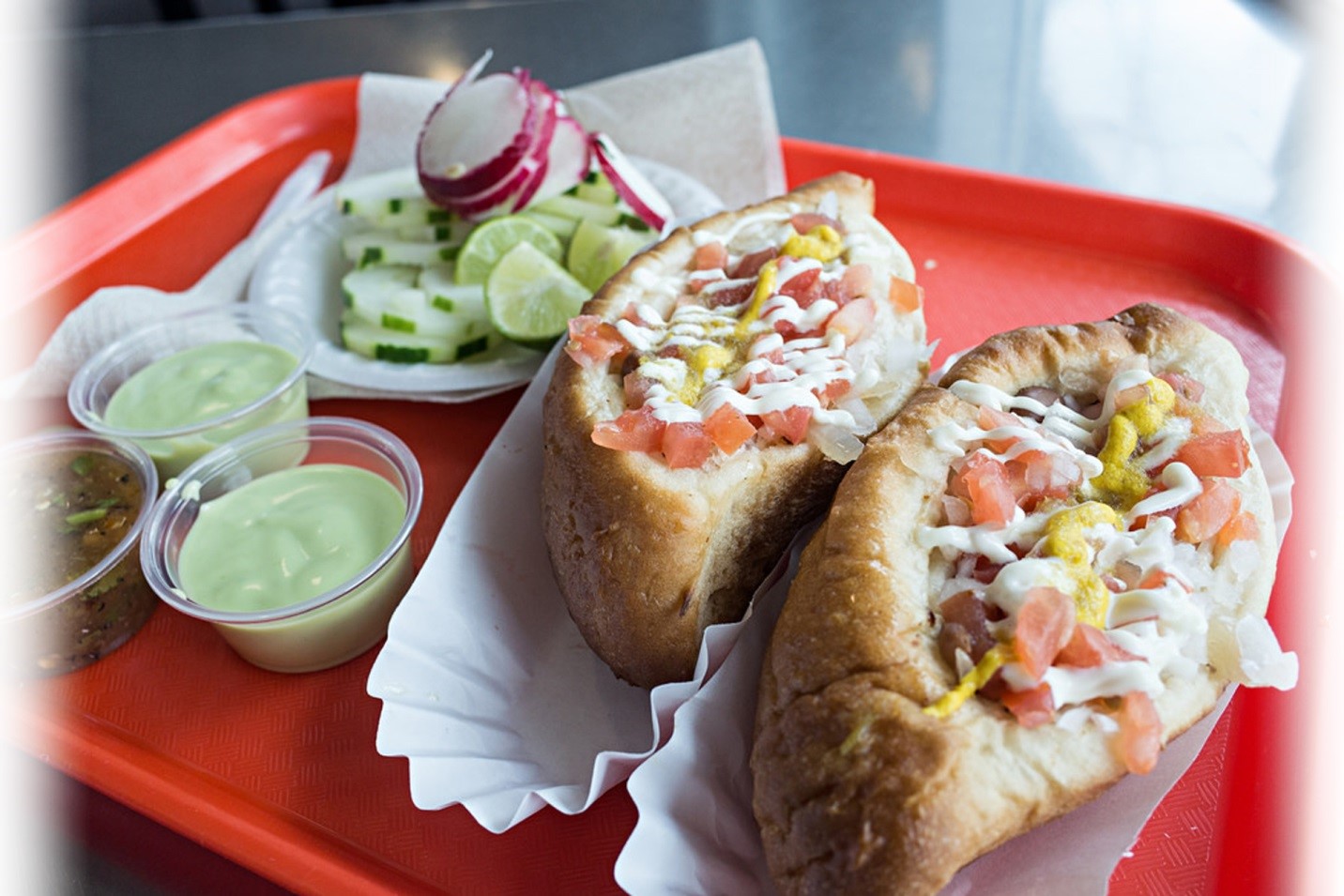
Our summer blog series “Perspectives from Anthropology of Food” presents work written by the students in the summer Anthropology of Food class (ML 641) in which they reflect on current issues, discuss assignments they have worked on, or address topics of particular interest to them. Today’s post is from Gastronomy student Karl Koch.
In this week’s classes, we’ve discussed the role of food in cultural transformation, which often led to the topics of authenticity, tradition, and “cuisine.” The gist is that cultures continue to adapt over time, spurred by new cultural, political, or economic stimuli, and foodways change as a result. Traditions and food rituals change, authenticity becomes more subjective, and cuisines are developed as intentionally put-forth products of culture, often for outsiders to be able to recognize. Many readers may be familiar with how formerly alien New World crops have become staples in Old World cultures in relatively recent history, like the example of Italian food and tomatoes, or Irish food and potatoes. The list goes on. If we held cultures to strict standards of tradition without the infusion of new ingredients and foodways, Southeast Asian foods would be without their signature spicy chili peppers. National Ethiopian cuisine would never have been created out of different regional foods and codified under the 19th-century reign of Empress Taytu, in part to emulate European monarchies and the elite foods they ate (McCann 2010: 64-99). The pre-contact Hawaiian luau would be nearly unrecognizable to contemporary residents of the island, whether ethnically Hawaiian or descended from the many immigrant groups that have come to call the islands home (O’Connor 2008: 167-168). People in the UK would not have the sugar to put in their tea!
The point is that cultures and their foodways are continuously changing. Nowhere was this more apparent to me than in my experience of living in Tucson, Arizona last year. Working at a small Catholic school on the predominantly Latinx south side of town, I was privileged to be exposed to many new foods through the generosity of others. Menudo, chilaquiles, the best pork lard-laden refried beans—these foods fit my expectations of traditional Mexican fare. But I also learned about the particularities of Sonoran foodways as apart from an overarching “Mexican cuisine.” For example, Sonoran tamales typically include a single green olive in the center, which is quite unusual compared to tamales from other regions of Mexico. But I was most intrigued by the so-called Sonoran dog, offered at the near-omnipresent street carts and food trucks. A bacon-wrapped hot dog in a fluffy, sweet bun, overloaded with beans, tomatoes, avocados, mustard, and mayonnaise, the Sonoran dog became a quick favorite of mine. But was this traditional? Was it authentic?
For the residents of Tucson and elsewhere in the Arizona-Sonora region, yes. True, the American ballpark-staple hot dogs may originate in the Austrian capital of Vienna (Wien in German, people from which are called Wieners). And true, mayonnaise may be some French-origin sauce that is now a typical sandwich condiment. But in this mash-up of cultures, you get a uniquely Mexican-American product. As Ted Robbins reports for NPR, the Sonoran dog and other borderland foods like fish tacos, chimichangas, and margaritas have spread both north and south (2009). One hundred years ago, tortilla chips would have been just as unfamiliar in Mexico City as in Chicago. To this extent, the Latinx people of Tucson may share more cultural practices and foodways with the people of southern Colorado than in Oaxaca in southern Mexico (see Carole Counihan’s A Tortilla is Like Life: Food and Culture in the San Luis Valley of Colorado, 2009).
With what I have learned through this course, I can now see how the people of Tucson navigate different identities and interact with multiple layers of overlapping cultures: Mexican, Sonoran, American, indigenous Tohono O’odham and Pascua Yaqui. As E. N. Anderson notes in his chapter on foods and borders in Everyone Eats, “food and foodways have been internationalizing for centuries” (2005: 208). So while a Sonoran dog may initially strike an outsider like myself as alien or jarring due to previously held notions of Mexican cuisine, the Sonoran dog is not any less authentic than menudo or chilaquiles. Yes, it is a hybridization of American and Mexican foodways, but the Sonoran dog is a perfect example of how cultures create something new out of different sources. Cultures and their foodways are dynamic and constantly transforming, especially in borderland cultures. Isn’t that a tradition unto itself?



